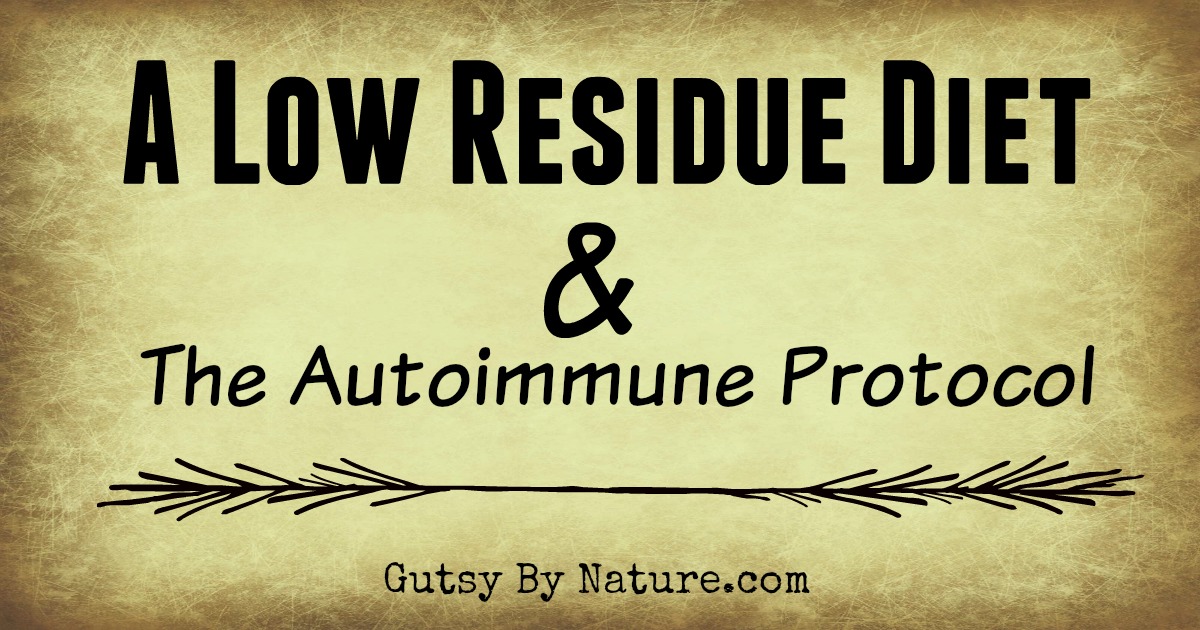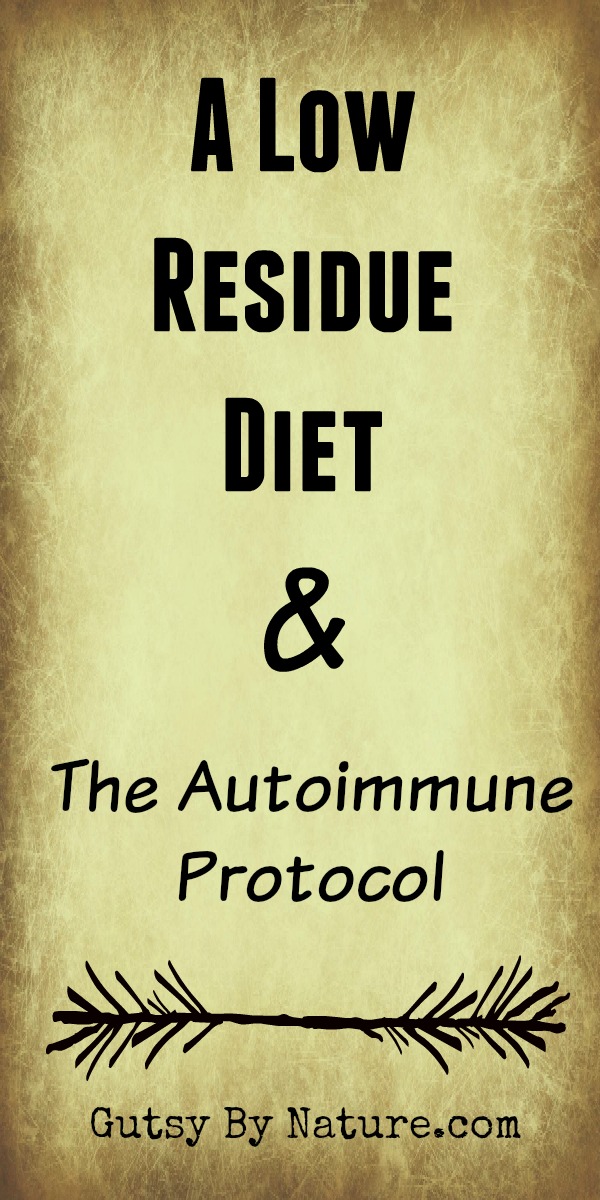A “low residue” diet is often advised for individuals who are preparing for a colonoscopy or other medical test, who are preparing for or recovering from surgery on the small or large intestine, who are recovering from a bowel obstruction, or who are experiencing severe inflammation from active Crohn’s disease or ulcerative colitis. It is not a “healing” diet, but a diet to provide short-term therapeutic effect.
If your doctor has advised you eat a “low residue” or “low fiber” diet, it is very important that you follow this direction and consult with your doctor before discontinuing it, even if you begin feeling better.
WARNING – Fiber is an important and necessary component of a healthy diet. These recommendations are only for people who have a short term medical need to eat very little fiber and are intended to be followed for only as long as necessary. Always consult with your professional medical care team before making dramatic dietary changes.
The list of allowed foods on a low residue diet provided by your doctor likely includes many things that are not normally allowed on a healing diet like the autoimmune protocol (AIP), such as processed grains, sugary baked goods, and dairy, which leaves many people confused. They wonder, “Should I be following the advice of my doctor?” or “Should I continue AIP?”
The correct answer is: You can and should do BOTH! Continue to follow AIP, but exclude all high fiber foods.
So let’s talk about…
How to eat an AIP low residue diet
As much as I dislike giving my clients rigid rules for eating, the low residue diet is an exception because the stakes can be so high. Depending on the reason you have been directed to eat this diet the consequences could range from having a colonoscopy be less accurate to as severe as a bowel obstruction or post-surgical complication. So let’s break this down into three categories of guidelines: the things you must do, the things that you could do to make the experience easier, and the things you must not do.
Must Do
DO eat! If you are on the low residue diet for more than a couple days, you must make sure you are eating enough to get the nutrients you need and keep up your strength.
DO drink bone broth, preferably homemade. Aim for 3 servings or more per day in order to provide your body with plenty of nourishment.
DO eat 7+ servings per day of well-cooked, low fiber vegetables, preferably organic. Acceptable AIP-compliant options include:
- Asparagus
- Beets
- Carrots
- Cauliflower
- Celery Root
- Squash (all types)
- Zucchini
DO eat 3+ servings per day of well-cooked meat, poultry, fish, seafood, and offal. Ideally, beef should be grass fed, pork and poultry should be pasture raised and/or organic, and fish and seafood should be wild caught.
DO consume healthy fats, like coconut oil, olive oil and fat from grass fed or pasture raised animals, with each meal.
DO eat 1-2 servings per day of low fiber fruits, preferably organic. Riper fruits will be even easier to digest and peels should always be removed. You may also choose to eat cooked low-fiber fruits and fruits that have been canned without added sugar. Acceptable AIP-compliant options include:
- Bananas
- Melons
- Apples (cooked or canned)
- Peaches (cooked or canned)
- Pears (cooked or canned)
Maybe Do
You MAY drink vegetable and/or fruit juice with all pulp strained out, as long as it is made from AIP-compliant ingredients. If you are going to be on the low residue diet for a lengthy period, you may wish to invest in a quality juicer in order to make fresh juice at home.
You MAY make homemade gummies from gelatin and pulp-free juice.
Must NOT Do
DO NOT eat any raw vegetables.
DO NOT eat any high fiber vegetables, even if they are cooked.
DO NOT eat any high fiber fruits, citrus fruits, or fruits with small seeds, such as strawberries.
DO NOT drink prune juice or any juices with pulp.
DO NOT eat any foods not allowed on AIP, unless you have previously reintroduced them successfully.
Note: I have created a simple one page PDF version of this information for my clients to post on their refrigerators for easy reference. I would be happy to email it to you also; just click the button below.





7 replies on “Is it possible to eat a Low Residue Diet and stay on AIP?”
I had a total colectomy 2 years ago ( with an anastomosis) . Fiber bothers me, as does too much fat( both cause diarrhea). I try to follow the Fast Tract Diet plan, but struggle to find enough variety in my diet. Do you have any suggestions?
Thanks,
Linda
I can’t give you personalized advice of course, but I can tell you that some things that have helped my clients and myself after surgery include: fresh vegetable juice, cooked and pureed soups, and meal timing. Supplementing with MCT oil and collagen powder as well as other gut healing supplements, depending on individual needs is helpful and I also explore digestive enzymes and have clients experiment with different probiotic strains.
Are cauliflower and asparagus really considered low-fiber? My husband has had 2 bowel obstructions in the past year (resulting from adhesions from a surgery he had when he was 2), and has really struggled with his diet. We both ate paleo prior to all of this happening, but he is understandably scared of anything high fiber. He’s also started to get sick super often lately and we’re sure it’s because he’s not getting adequate nutrients from his diet (he eats a lot of quality meat, healthy fats, eggs, sweet potatoes, squash – stuff like that), but we don’t know how to incorporate them. We are working with a wonderful naturopathic doc (since the surgeons and everyone else told us to expect 3 surgeries a year for the rest of his life – he’s 31!!). Do you have any advice as to how to incorporate nutrients normally found in foods like broccoli, kale, spinach, etc? We of course will talk with his doctor, but just wondering if you had any ideas as someone who works in the paleo/AIP world.
Thank you for the helpful tips!
[…] of that above mentioned fiber, people who have been advised to temporarily eat a “low residue” diet should stay away from mushrooms. Also, mushrooms are a “high FODMAP” food, so they may […]
It’s rare to find these diets discussed together. Super helpful.
Thank you for this guide! As someone who eats tons of raw veggies and kale daily, I have struggled with this.